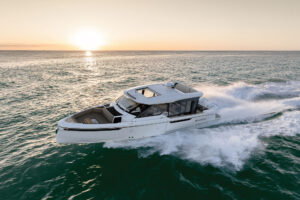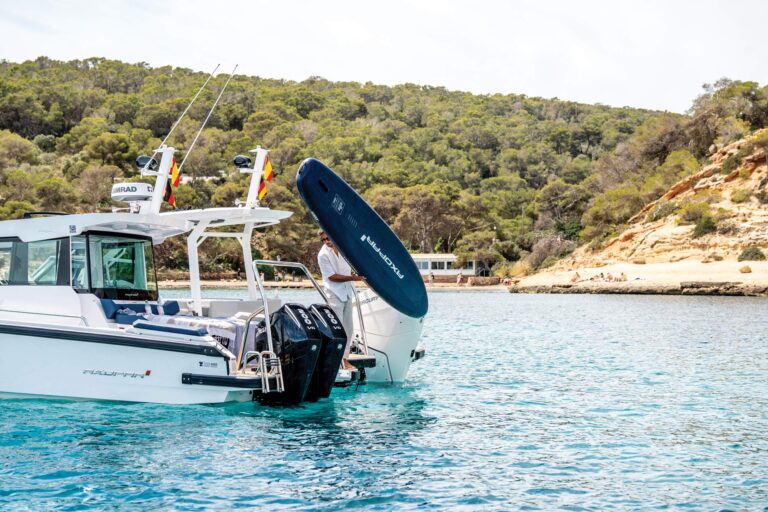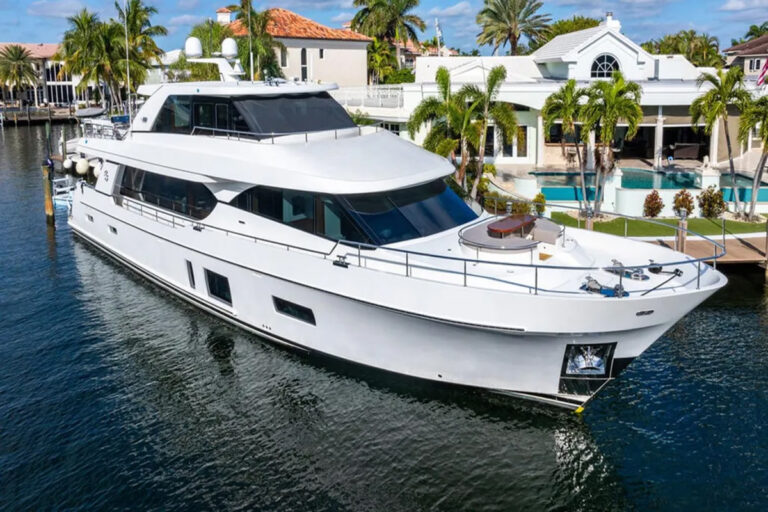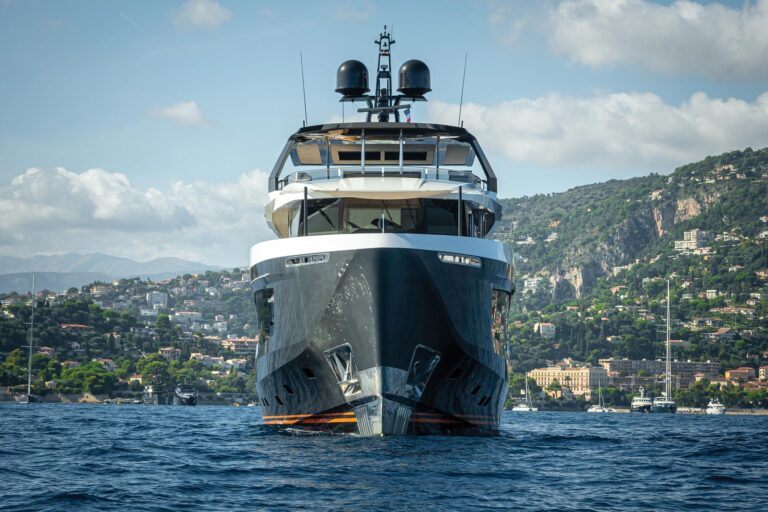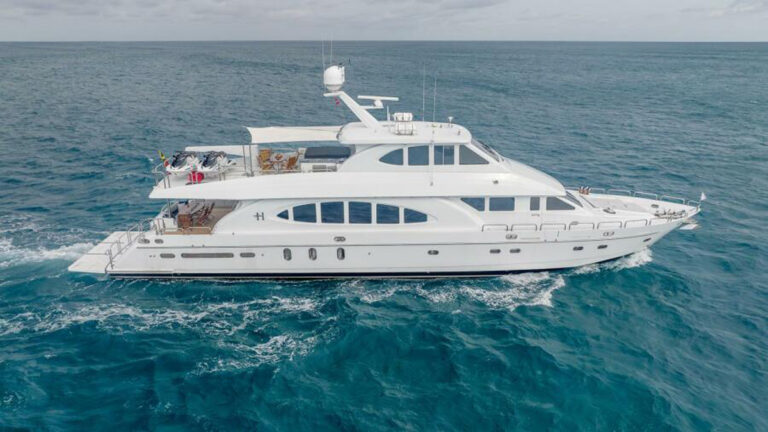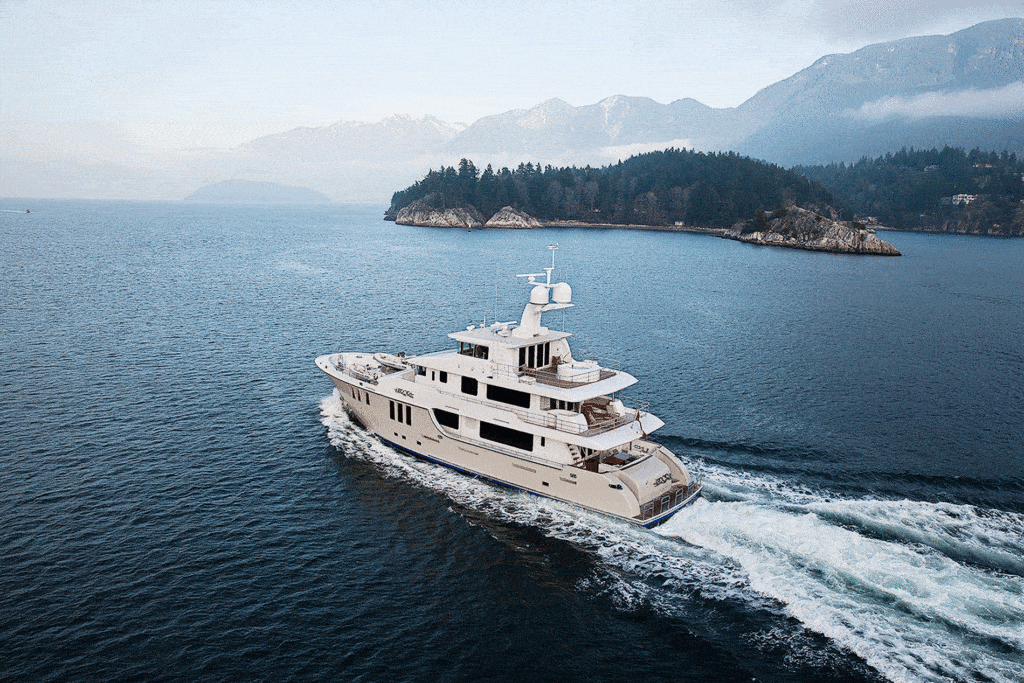
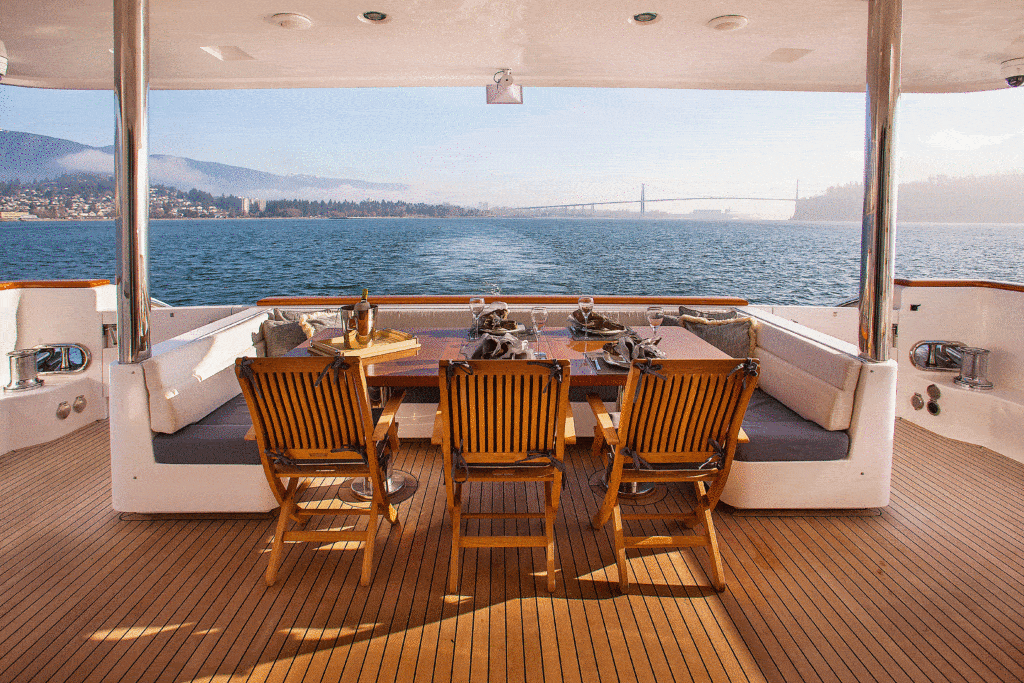
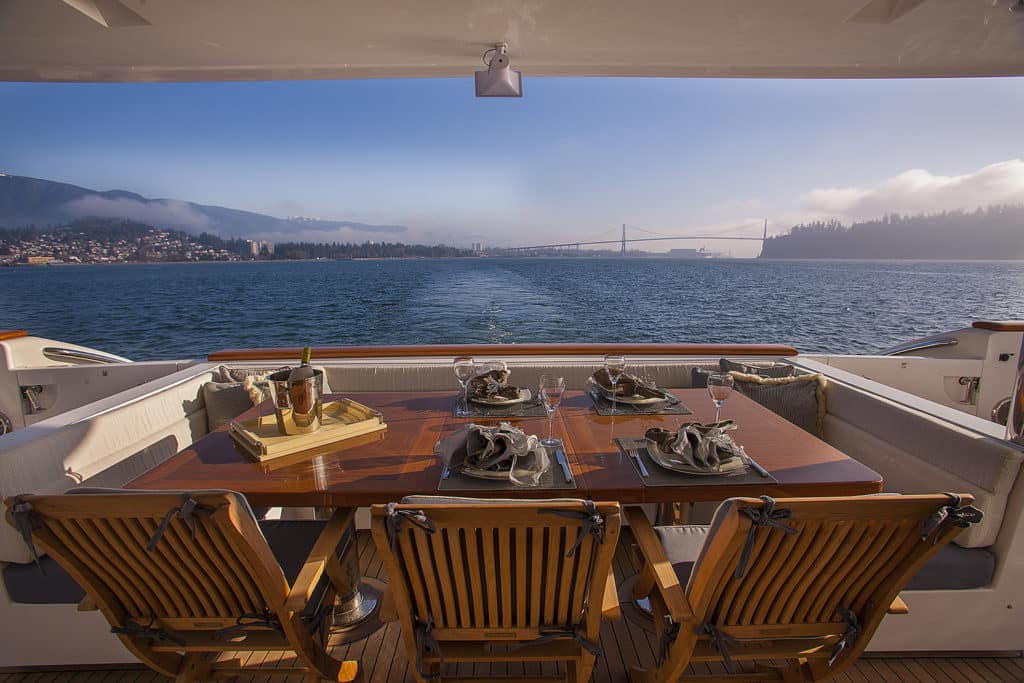

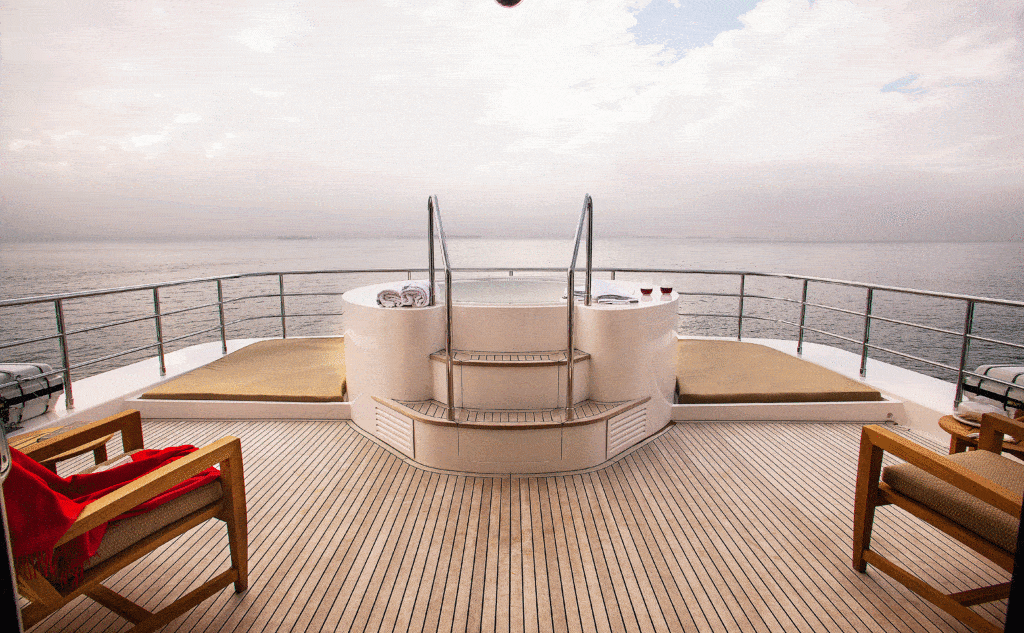
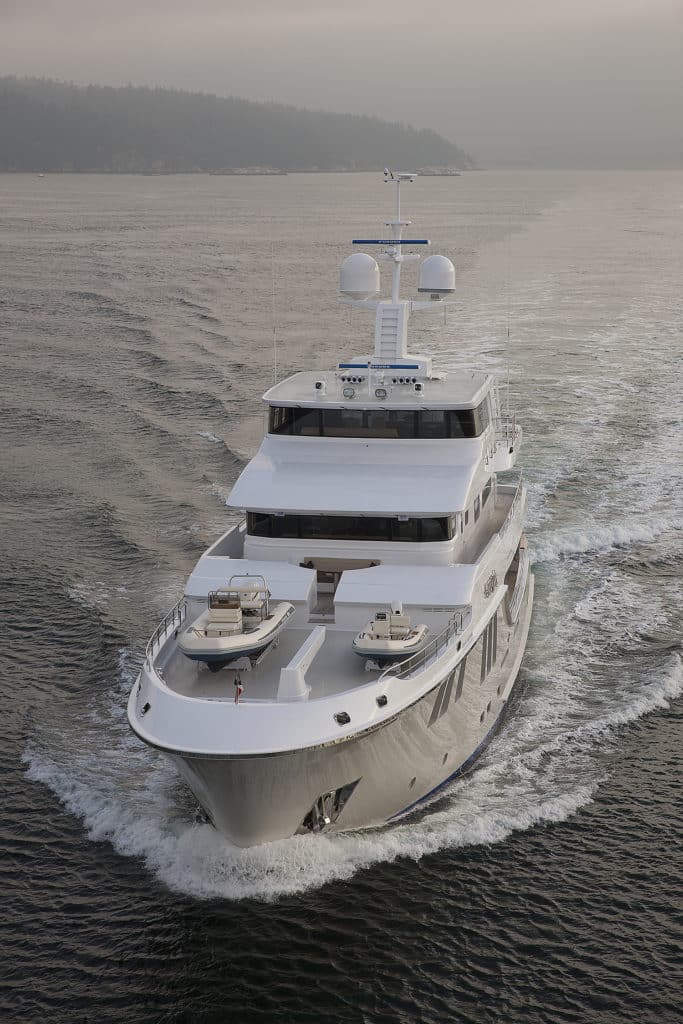

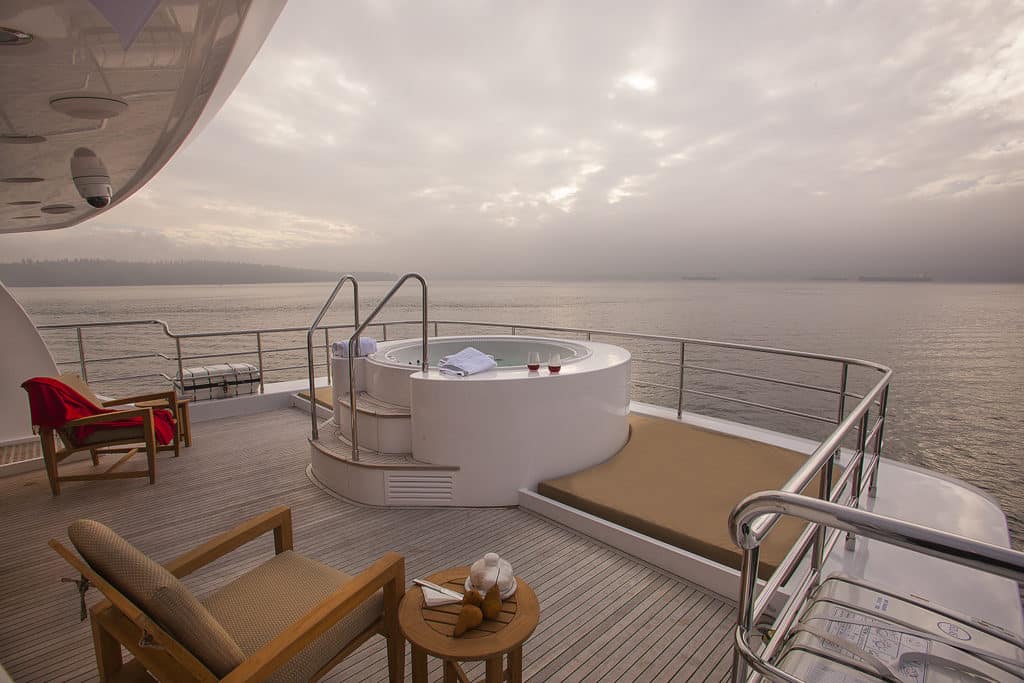
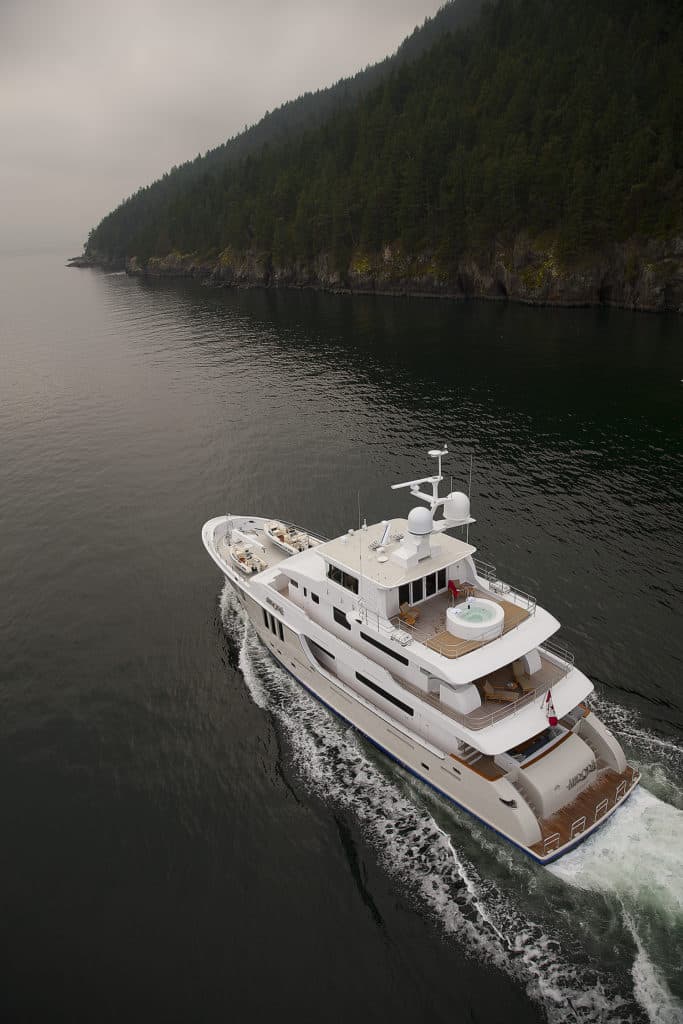
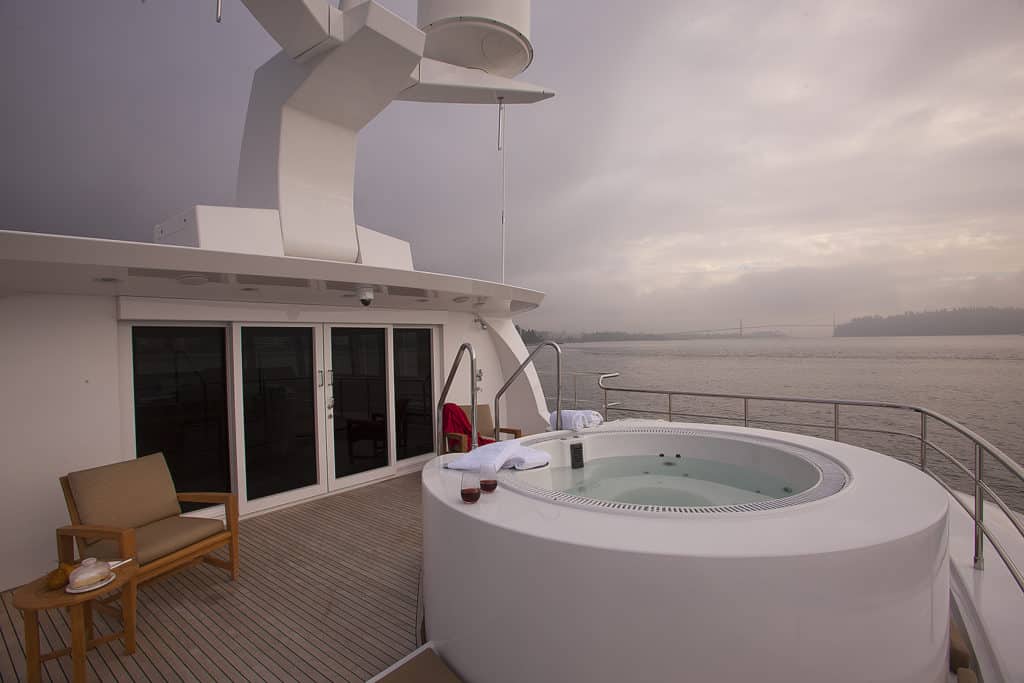

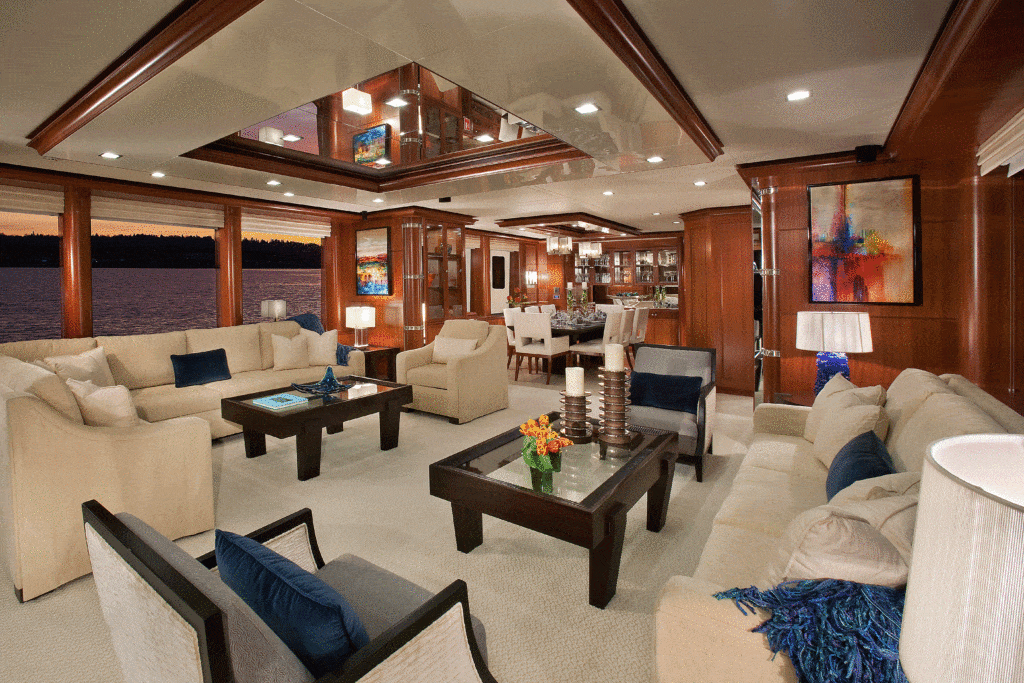

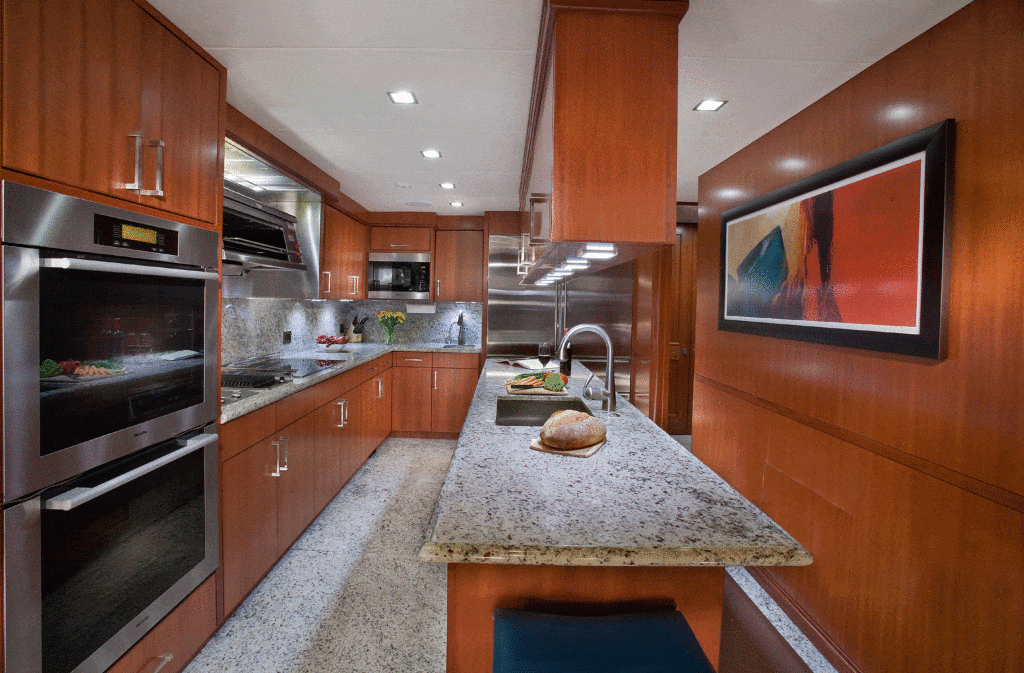

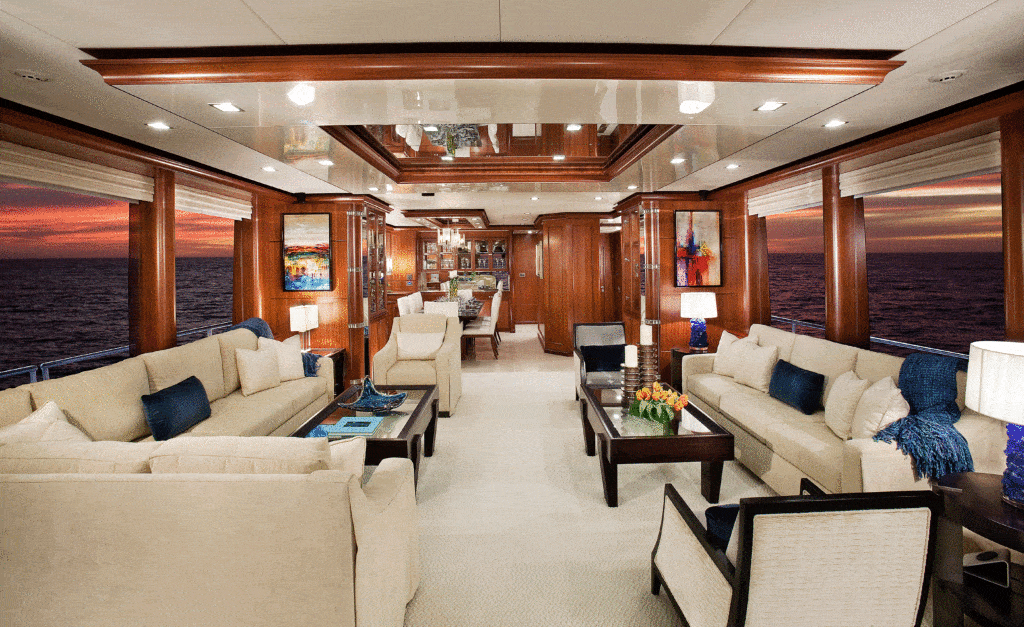



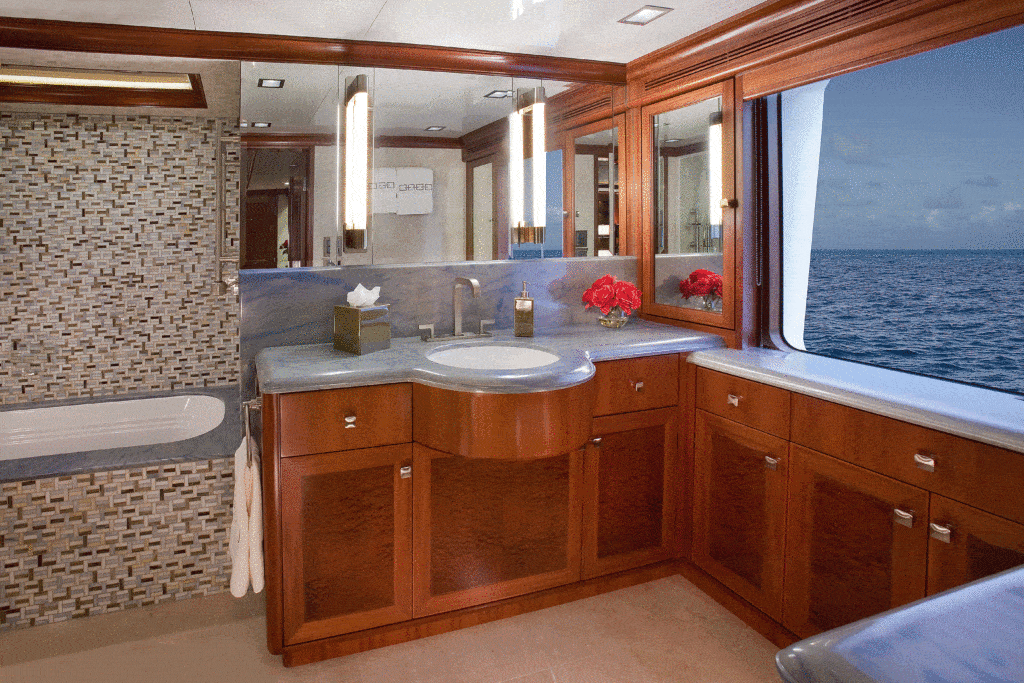
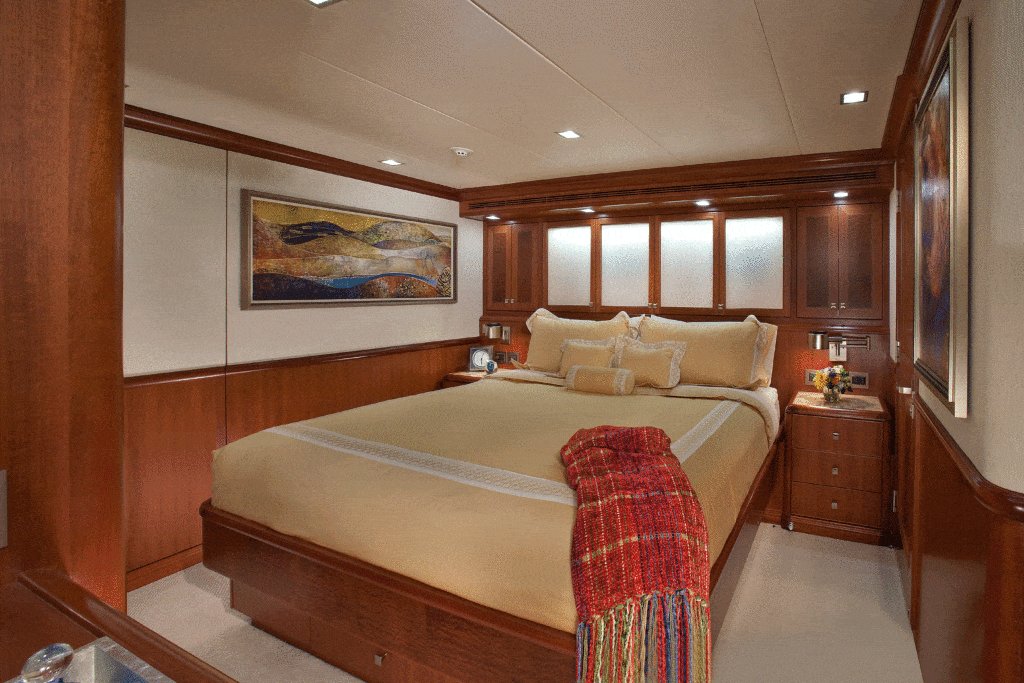
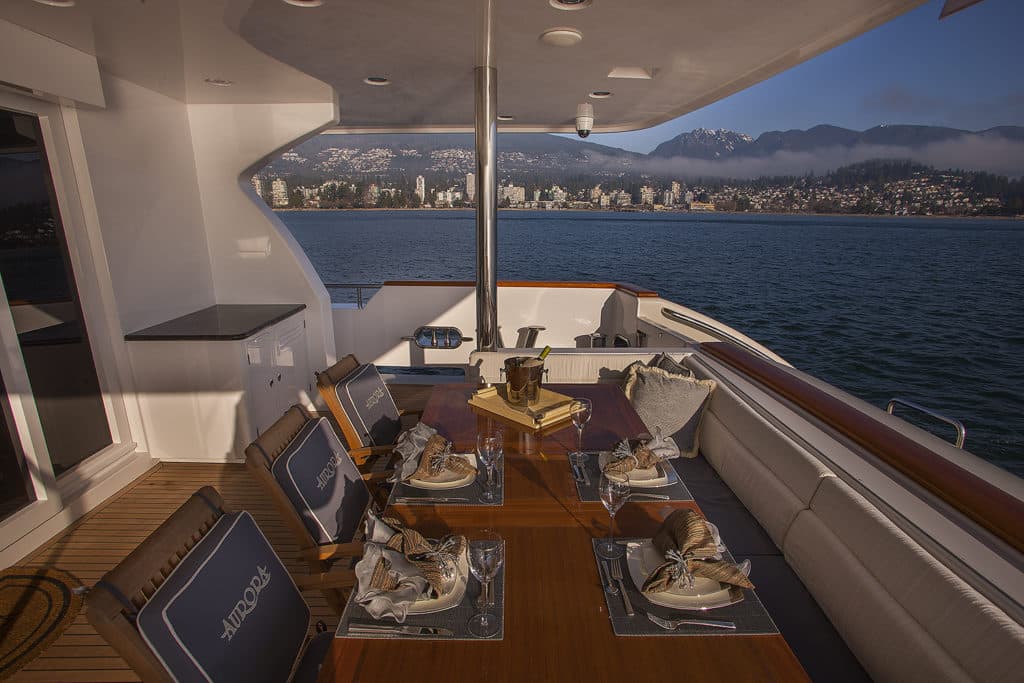
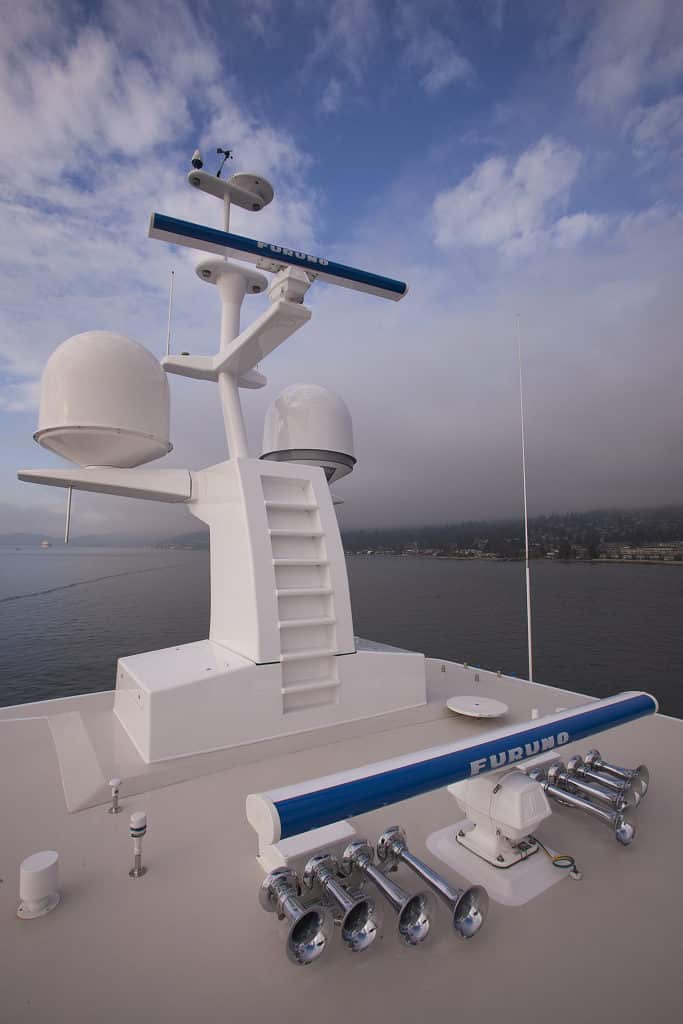
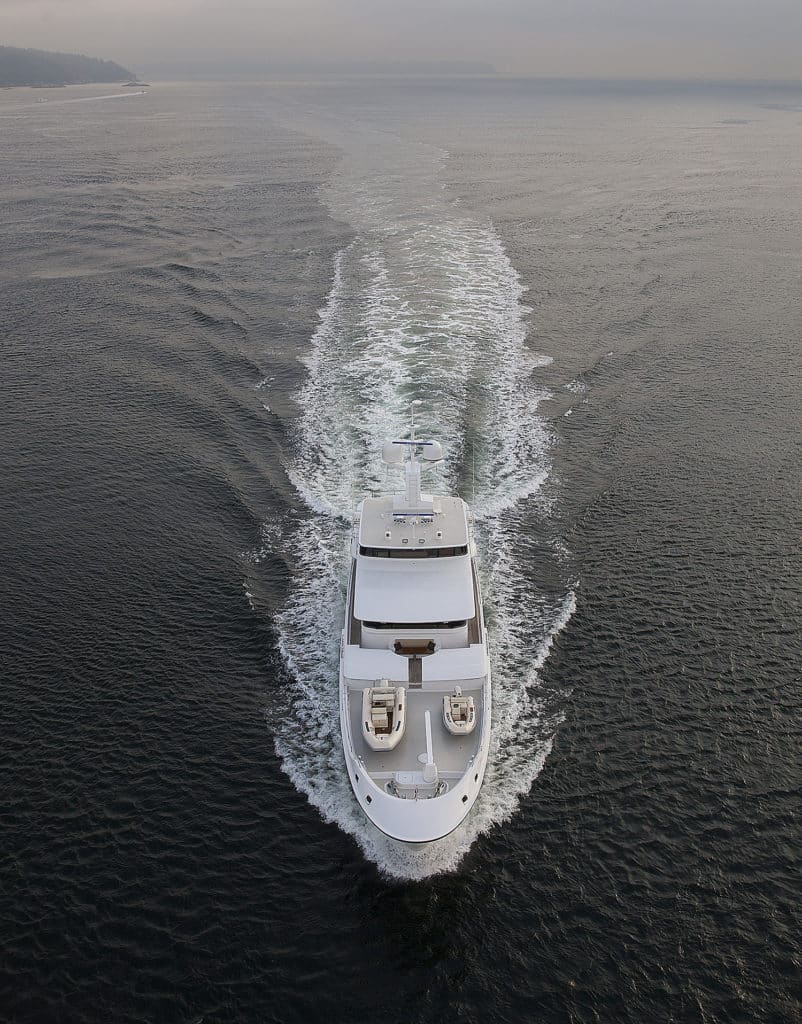
Nothing says seaworthy like a transpacific shakedown cruise, but exploits of this scale are nothing new to the [Nordhavn][] brand. As the builder now enters the megayacht sector with a 120 trideck, it comes from a history of increasingly impressive blue-water credentials.
The principals of parent company Pacific Asian Enterprises (PAE) cite the influence of Capt. Robert P. Beebe’s book, Voyaging Under Power, as a factor in their 1987 decision to transition from building a successful line of cruising sailboats to becoming a major player in the long-range power-cruiser category.
Beebe’s convincing assertion that a well-designed and well-built powerboat would be capable of long-range, bluewater cruising came at a time when that corner of the recreational boating market was the domain of sailing yachts and the largest motoryachts, and it resonated particularly well with the trio of young entrepreneurs.
The three — brothers Jim and Jeff Leishman and partner Dan Streech — had been contemplating a move into the power-cruising sector since the mid-1980s. Given their collective personal experience, including a number of offshore and transoceanic passages under sail, they had little difficulty matching Beebe’s thesis to their own aspirations.
Accordingly, in 1989 PAE launched the first of its 46-foot, single-screw, diesel-powered cruisers, even then bearing the signature tall, high-freeboard profile and robust composite construction consistent with seagoing mettle. During the ensuing 2½ decades, the company expanded its offerings with a succession of ever-larger designs up to 86 feet, several with twin-engine propulsion — but also backfilling the range now and then in answer to market demand. The smallest of the current Nordhavn fleet is a popular 40-footer, one of which completed a circumnavigation in 2002. Along the way, PAE has sponsored a sequence of owner events, including the Fort Lauderdale-to-Gibraltar Nordhavn Atlantic Rally of 2004, attended by 15 Nordhavns in an emphatic statement of the brand’s big-water credentials.
The more recent introduction of the Nordhavn 86 landed PAE squarely in the large motoryacht category as a logical extension of a line that has earned the builder a loyal following of owners, many of whom have been moving up through the size range. Even so, it was a big leap to add a 120-foot, long-range expedition vessel to the Nordhavn resume, all the more so during a time of global economic uncertainty.
In one sense magnifying the stress, but in another cementing the resolve of PAE’s management team, the company also committed to build the all-composite 120 not in its Taiwan facility, but instead in a brand-new construction hall in Xiamen, a busy port city on the Chinese mainland. Work began on the new yacht in late 2008, only to face an untimely challenge when, because of the gathering financial turmoil of the time, the original owner canceled his order. On the strength of its conservative business model, financial position and order book that any builder would envy, the PAE team continued the project uninterrupted. Before long, a Canadian couple — longtime cruising enthusiasts and three-time Nordhavn owners with aspirations to move up from their 86 — stepped in as the new owners.
“The contracts were signed prior to the deck tooling being completed,” said PAE partner and naval architect Jeff Leishman, “which allowed the owners to make certain changes to suit their needs.” Among the alterations to the inaugural 120, Aurora, was a redesign of the flybridge deck and supporting structure to accommodate the owners’ cold-water cruising needs in British Columbia.
Originally, there was an open sun deck with cover. Now, the level is enclosed with an upper helm and salon. And while the addition brought displacement to a substantial 880,000 pounds at full load, the yacht’s underlying lamination schedule, substantial ballast and robust scantlings proved more than equal to the added weight. The ABS-class hull is fabricated in solid fiberglass from keel to 18 inches above the waterline with Corecell-core topsides. House sides are cored with Klegecell rigid foam, and cabin tops with end-grain balsa; stringers, frames and watertight bulkheads are built and installed to ABS mandates.
| Specifications | Builder Supplied Number |
|---|---|
| LOA: | 120’7 |
| BEAM: | 27’11” |
| DRAFT: | 9’0″ |
| DISPL.: | 880,000 (with enclosed top deck and full load) |
| FUEL: | 17,500 gal. |
| WATER: | 2,800 gal. |
| ENGINES (tested): | 2 x 965 hp MTU diesels |
| BASE PRICE: | Upon request |
In keeping with Aurora‘s expedition-capable musculature is an exterior style that, while clearly recognizable as a Nordhavn, leverages hull length to impart a svelte elegance appropriate to the large-yacht genre. “We wanted a stylish exterior design,” Leishman noted, “that would maintain a certain amount of ruggedness in order to define her intent.” An elongated foredeck and raked coamings balance a tall superstructure profile well aft. The custom-built signal mast folds down by way of a pantograph-type mechanism that keeps antenna domes upright and reduces overall height to fit within confines of the owners’ covered moorage. Among the yacht’s slick exterior features and preserving hull-side contours is an Opacmare hydraulic boarding stair that can be concealed in a stowage bay to starboard.
Large windows add texture to Aurora‘s exterior and suggest an abundance of natural lighting within. Interior themes reflect dual priorities of elegance and informality, with an emphasis on family activities and a division of spaces that offers privacy while encouraging more social pursuits.
Common areas include a main-deck salon with fixed and loose furnishings that promote quiet conversation, leaving ample room for occasional dockside receptions. In the adjacent dining room, a 10-place table stands within a perimeter of cabinets for china and glassware. A service door here opens to a galley with floor plan and fit-out — including commercial-grade appliances, broad stone countertops and the obligatory, copious wine cabinet (with additional units in each of the two upper-deck lounges) — that reflect the owners’ shared passion for cooking, chef or no chef.
Other common areas include a bridge-deck lounge with bar and sliding-door access to a covered deck area just aft, and a top-deck sky lounge that opens to an aft sun deck and hot tub, offering some of the best views from on board. Interior decor, by Destry Darr Pethtel of Destry Darr Designs, features American cherry joinery with neutral wall and floor coverings and fixtures of polished chrome and satin nickel, all contemporary with classic trim and accents, and with contrasting splashes of color in accents and original art.
A companionway leads forward from the starboard-side foyer through a private office to the owners’ suite with his-and-hers baths, a built-in vanity and dressers, dual walk-in wardrobes and a king-size bed on centerline. Tall hull-side windows admit daylight and allow for dramatic views port and starboard.
Belowdecks, the amidships engine room separates guest accommodations, with two en suite staterooms forward and two aft on the starboard side. Crew accommodations, well forward on the lower deck, include two cabins with upper and lower bunks plus a third single cabin, all en suite, and a large crew mess with dining settee and service access to the two forward guest staterooms. A queen-berth captain’s suite adjoins the bridge-deck pilothouse.
The owners’ enthusiasm for advanced navigation electronics becomes apparent with a quick scan of both helm consoles, one in the main wheelhouse and the other on the top deck, each featuring six screens (plus engine status panels) for inputs from GPS, radar, plotter, Fathometer and a comprehensive onboard monitoring system.
Both stations offer a clear view ahead through a centerline windshield pane that spans nearly 8 feet from side to side, and whose five-eighths-of-an-inch thickness meets ABS specifications. While the upper helm may seem redundant, it does offer a higher vantage point for negotiating tight channels so common along the Canadian Pacific Coast, or for spotting barely visible floating hazards in the yacht’s home waters, where an active forest industry too often releases stray logs that threaten propellers, stabilizer fins and even the hull itself. Cheap insurance, perhaps.
| RPM | KNOTS | GPH | dB(A) |
|---|---|---|---|
| 600 | 4.9 | 8.0 | 52 |
| 1000 | 7.0 | 12.0 | 58 |
| 1500 | 10.7 | 32.0 | 61 |
| 2000 | 13.4 | 70.0 | 66 |
| 2245 | 14.0 | 100.0 | 79 |
Following Aurora‘s launch and sea trials in late 2013, Nordhavn began the delivery plan, which, while entirely consistent with the yacht’s design, construction and provenance, was also ambitious by any measure: a late-year North Pacific crossing, via the Aleutian Islands, no less, en route to the Vancouver-area home port.
With the owners on board for the greater part of the voyage, Leishman and his team seized the opportunity to test, monitor and record every aspect of the yacht’s operation over an extended period in a variety of weather and sea conditions, with a full complement of passengers and crew, 14 in all. “This gave us a great opportunity,” he said, “to confirm that what we set out to achieve in the design did indeed work as planned.” Port calls along the way included remote Adak Island and Dutch Harbor, the busy but often battered hub of Bering Sea commercial fishing operations. Burrard Inlet in Vancouver was the terminus of a nearly 6,000-nautical-mile, 29-day odyssey.
Given the yacht’s heavy displacement, the ride feels predictably solid on an active sea. The bow bulb, in addition to diminishing the amplitude of the bow wave for an attendant gain in fuel efficiency, also dampens the hull’s pitching movement, and the four-fin Trac stabilizer system checks roll. Factoring a 10 percent fuel reserve and with one of two 65 kW generators running, the twin 965-horsepower MTU mains deliver a 6,270 nm range at 7 knots. While the owners plan to continue cruising extensively — perhaps exclusively — aboard Aurora through the numberless waterways and quiet reaches of the Pacific Northwest and Inside Passage to Alaska (perhaps following in the wake of Robert Beebe and many of Aurora‘s Nordhavn forebears), few destinations worldwide lie beyond their new yacht’s reach.
Fit-Out for Global Navigation
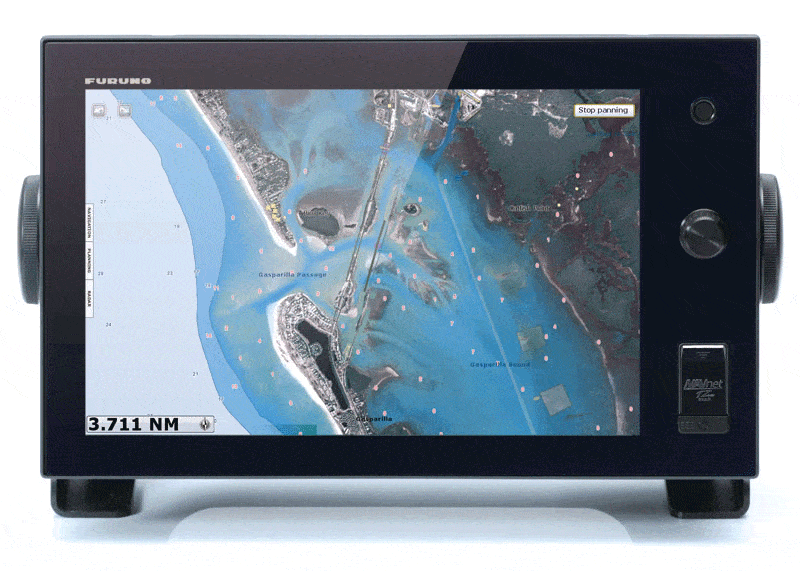
Aurora’s owner spent three years sourcing a sophisticated suite of navigation hardware and software. His search was guided by four general principles: To the greatest extent possible, a single vendor is preferable for connectivity of components, documentation and technical support; products built to meet a price point are often less robust and lack absolute connectivity; black box technology enables the user greatest flexibility in arranging the display of navigation information; redundancy is critical to avoiding dependence on any single hardware component and ensures backup data sources. Consequently, the electronic navigation system aboard Aurora is based on a Furuno NavNet 3D software package including radar, GPS and plotter and serving additional Furuno components, which include two VHFs and SSB, Doppler speed, three depth sounders, a weather station and eight monitors. Additional components include Nobeltec Trident software, a Simrad AP50 autopilot, a custom VSAT package and a Boening vessel-monitoring system. While the owner’s search produced a number of worthwhile alternative options, each offered a common attribute that ultimately merited his consideration. “The most important factor was quality,” he says. “The incremental cost for the best is small compared to the aggravation and time expense of making the wrong product decision.”


